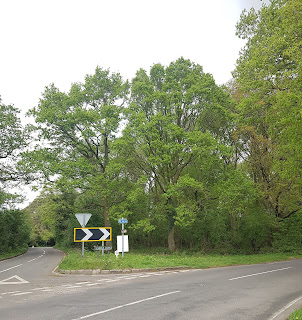Back
in the day, there was a whiff of the Wild West about Cookham. Hard to
believe I know! The problem was basically The Dean. Harder still to
believe? Even in the 1800s, Cookham Dean was already a very old, higgledy
piggeldy group of settlements. There was no centre at such, people
had set up home where they landed - The Mount, Starlings Green, Cookham Dean
Bottom and Winter Hill - and these settlements were barely connected by
tortuous roads. At this time, Cookham Dean was hugely agricultural,
the hillsides were covered in fruit trees – lots of cherries as you may know, but apples,
walnuts and even soft fruit like strawberries too. With this, came great poverty and
transient labourers. Grubwood Lane marked the boundary between Cookham
and the Bisham estate and so it was also a gypsy encampment. With little
respect for the law and a partiality for poaching, they knew that the
jurisdiction of Cookham’s distant police constable could be outwitted simply by
stepping from one side of the road to the other. Mind you, the long arm
of the law was easily twisted anyway. It was not unusual for the
Constable to be “invited” up to the Dean, where his generous hosts would treat
him to their finest liquid refreshments, safe in the knowledge that he was
distracted from policing. So the structure for this community was
defined by nature, the seasons and work. There was no school, no church, no
community record keeping, little in law enforcement and a developing rivalry akin to
Manchester City vs. Manchester United, between the two ends of the village.
Hence the comparison to the Wild West. However, some of the good people of
Cookham village, worried for the souls of the Dean – “the most notoriously evil
parish in the diocese of Oxford”. The Reverend George Hodson sounds like the
Ross Kemp of ecclesiastical service. He was tough as old boots, had a notorious gun-slinging brother and had no issue holding his own with his unruly congregation. He started preaching from a
cottage, but by 1845 he had built the church we know as St. John the Baptist and arguably perhaps,
started to close the gap between the village and the Dean. There is of course
another well-known corner stone of village community - the pub. Of which
there has always been many in Cookham Dean. All have stories, especially
about the Landlords who I imagine would also have been as tough as Grant Mitchell, I
mean the Reverend Hodson, himself. In 1827 one William Copas, A King’s
Barge man from London, moved to take on The Chequers in Dean Lane and thus began a
family association with the village that you will know is still very much alive
today. The pub overlooked Bottom Well, also called the Redan, which was
the only source of drinking water in the Dean. Passing through the generations, by 1903 it was Mary Copas (and her pet sheep)
that was landlady. A widow, she too must have been a force to be reckoned with.
This Grade II listed building, parts of which are thought to date from the late
17
th century, has been successfully run
as a pub for over 190 years. However, it now lies
empty - apparently, it is not viable as it is. Nearly two centuries continuous use as a pub and it's not viable? I wonder what Mary Copas and all
the other landlords would make of that?
 |
| Mary Copas, landlady of The Chequers in 1903 - complete with pet sheep! |




Comments
Post a Comment